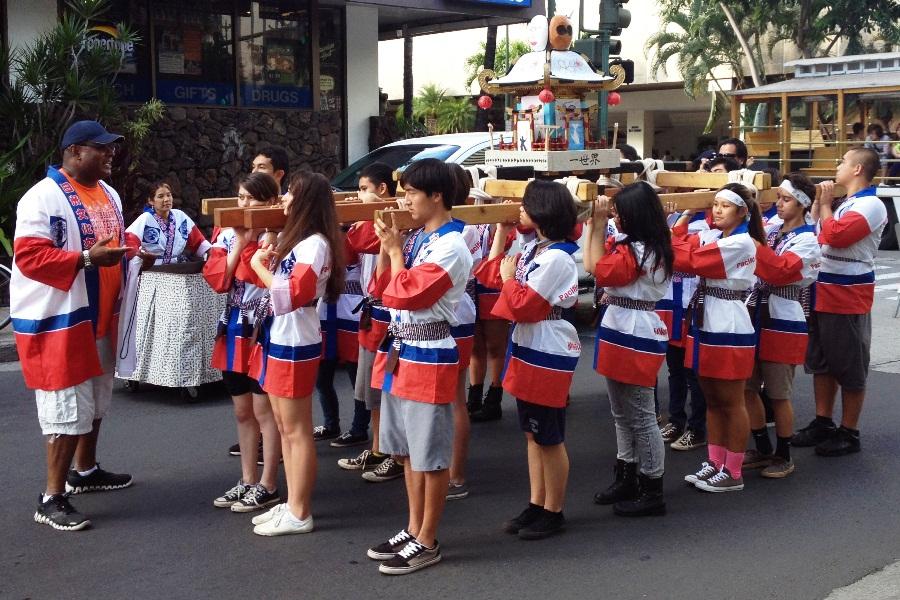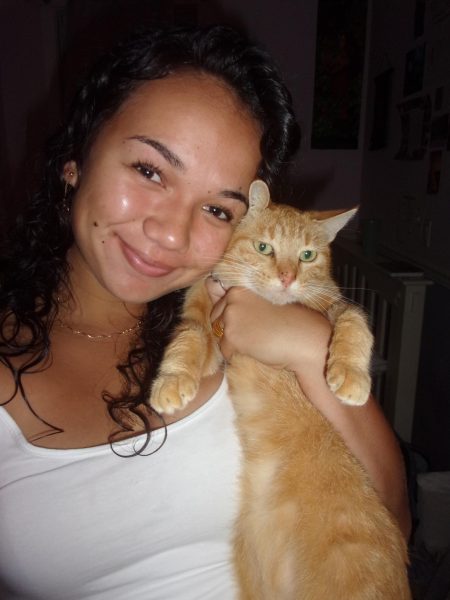Mikoshi win means pride, work, shopping!
Photo by Japanese Club
The Japanese Club heads out at the start of the Honolulu Festival parade in Waikīkī, March 9. Their design won the Maui Mikoshi design contest, and they won the privilege of carrying the mikoshi, brought to reality by the contest. coordinators.
March 16, 2014
In this guest-written article, junior Joelene Kuaana goes behind the scenes to show the hard work put into interpreting the annual Maui Mikoshi design contest theme, the excitement of seeing a winning design come to life, the pride in representing KS Maui at the Honolulu Festival, and all the other experiences (aka shopping) of the Japanese Club’s busy trip to O’ahu, March 9-10.
A Mikoshi, by definition, is a Japanese shrine that is traditionally held up on people’s shoulders during festivals. It resembles a house and is usually decorated in gold. If you asked the twenty students who attended the Honolulu Festival on the dense evening of March 9 what a mikoshi is, most would reply with “heavy.”
Although it is heavy, you shouldn’t be fooled by the bruises acquired by the students. The mikoshi we carried through the long streets was so much more than temporary bleeding and the drizzle of warm rain we endured.
The Japanese Club worked on our mikoshi design for weeks before we found it appropriate to submit. The theme, Jubilation: One Heart, One Pacific, and One World was the elephant in the room whenever we gathered as a council. How were we going to do this? How would we be original? Would we finish on time? Did we even have a chance?
We sacrificed a lot of things (one being the free SAT test date for the juniors) and gained a lot of things. As people, we fought and bickered and stressed over little things. Our determination to win two years in a row turned us hostile and competitive–sometimes with each other.
That all changed when Mr. [Kealii] Mossman met us by the stairs of the glass building and announced that we were winners. Nothing before that mattered because we won. We actually won, and we were going to attend the festival.
Weeks of anticipation, school work, and nights with four or less hours of sleep later, we were all packed up and ready to fly at seven in the morning.
The first day, a Saturday, was accompanied by the unveiling of our hard work. The deal with the Maui Mikoshi Contest is this: you submit the idea, and they make it. The mikoshi is revealed at the Convention Center on Oʻahu, and afterwards there are plenty of exhibits to attend, like the Cosplay Café, a booth dedicated to Nagaoka Fireworks, calligraphy, and even a picture-taking booth where you can rent a kimono to wear in your pictures. An obon dance is performed in the middle of the room with all the exhibits, and there’s a lot to eat, as well. When we had to leave the convention center to check into our hotel, we dressed up for dinner and headed out to Ala Moana Shopping Center to get some shopping out of our systems.
On the day of the festival, we met up with fellow parade-goers and socialized with various dance groups (modern and traditional), cultural groups (aborigine, Korean, and Chinese), and even some students from Maui. After practicing carrying the mikoshi and yelling the response of “Yashai!” to the leader’s “Yashoi,” we were ready to march by the time the sky turned dark and the city lit up.
The blocks we marched were long, the mikoshi slipped once or twice, and our legs were tired, but the energy of the crowd (some even joined in when we chanted) and the pure adrenaline of attending such a celebration surged through our blood and carried us through the enormous stretch of Kalākaua Avenue. This was what we were here for: to unite and to bear the honor of carrying this mikoshi, our mikoshi.
When we reached the end, we rushed to find a grand seat to the Nagaoka fireworks on the beach. Quiet. Then a giant blossom of fire erupted into the sky, and before we knew it, we were staring into a garden of flames. It was a spectacular sight, and, for once, we were all quiet as we watched the Nagaoka Fireworks become a new sun. The displays of green, blue, yellow, white, and pink lasted for nearly half an hour until the sky dimmed and the smoke cleared from the launching pad’s place out in the ocean. Still, it seemed as if the sky was stained with the color, and our hearts could not cease their quickened pace.
When Monday came around, we lugged ourselves to Waikīkī (more shopping), because we wanted to go to the parade again. We couldn’t believe it was over. Even as we packed our luggage, boarded the plane, and landed in Kahului once again, we could still hear the cheers for our mikoshi, feel the thunder of the fireworks, and smell the smoke from the pyrotechnics of the parade.



